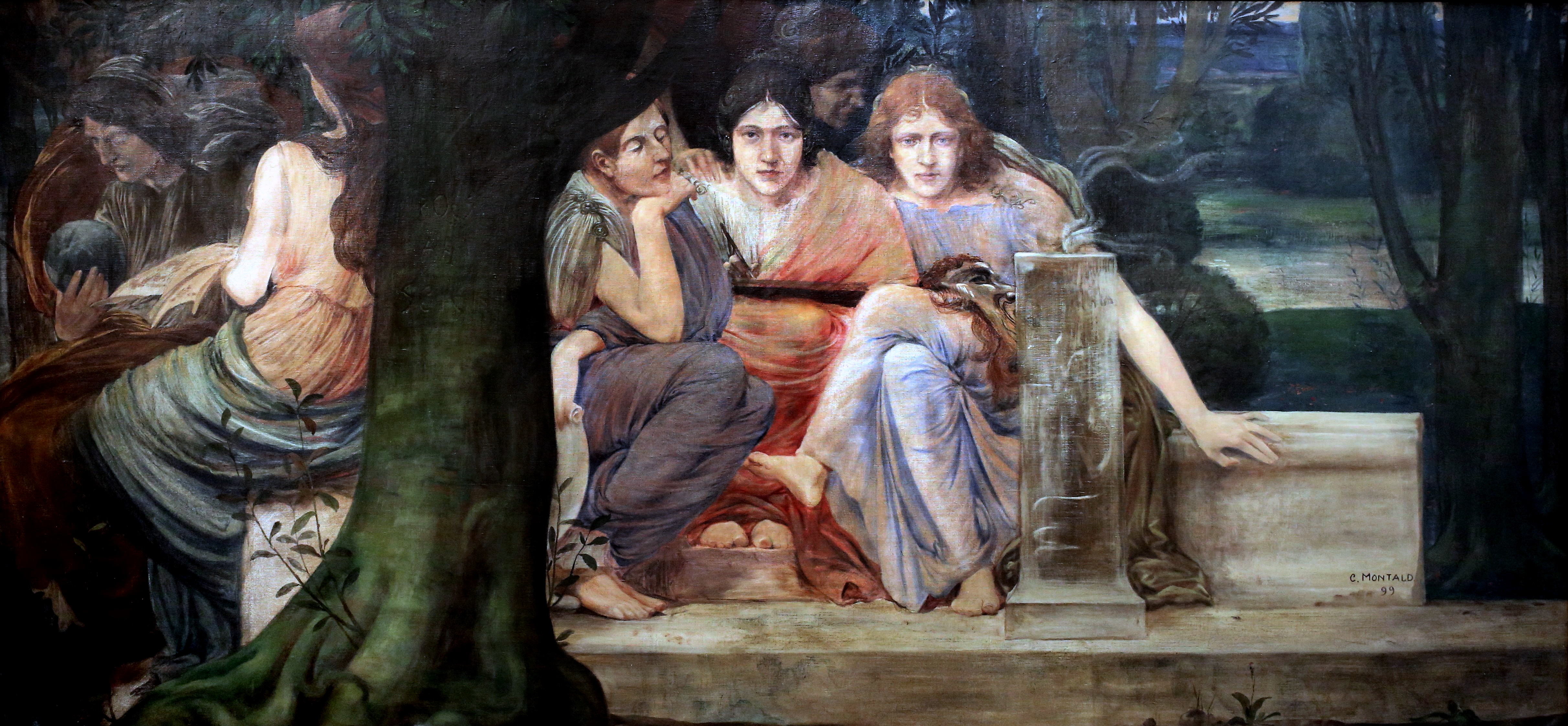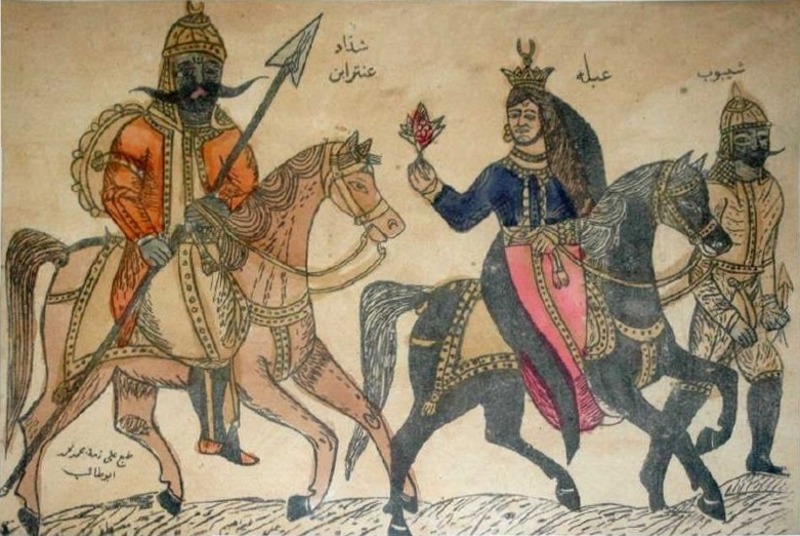|
RithƒБ'
RithƒБвАЩ ( ar, Ў±ЎЂЎІЎ°) is a genre of Arabic poetry corresponding to elegy or lament A lament or lamentation is a passionate expression of grief, often in music, poetry, or song form. The grief is most often born of regret, or mourning. Laments can also be expressed in a verbal manner in which participants lament about somethin .... Along with elegy proper (''marthiyah'', plural ''marƒБthƒЂ''), ''rithƒБвАЩ'' may also contain ''taбЄ•rƒЂбЄН'' (incitement to vengeance). Characteristics The genre was used by both male and female poets, and is one of the main genres in which ancient and medieval Arabic female poets are known to have composed. Almost all known pre-Islamic women's poetry is in this form. The subjects of the ''rithƒБвАЩ'' are (almost) invariably dead male warriors (''fursƒБn'') and lords (''sƒБdah''), predominantly those who fell in battle. The genre is prominent in the corpus of the earliest surviving Arabic poetry; it 'provides some of the most moving examples ... [...More Info...] [...Related Items...] OR: [Wikipedia] [Google] [Baidu] |
Arabic Literature
Arabic literature ( ar, ЎІўДЎ£ЎѓЎ® ЎІўДЎєЎ±Ў®ўК / ALA-LC: ''al-Adab al-вАШArabƒЂ'') is the writing, both as prose and poetry, produced by writers in the Arabic language. The Arabic word used for literature is '' Adab'', which is derived from a meaning of etiquette, and which implies politeness, culture and enrichment. Arabic literature emerged in the 5th century with only fragments of the written language appearing before then. The Qur'an, widely regarded as the finest piece of literature in the Arabic language, would have the greatest lasting effect on Arab culture and its literature. Arabic literature flourished during the Islamic Golden Age, but has remained vibrant to the present day, with poets and prose-writers across the Arab world, as well as in the Arab diaspora, achieving increasing success. History ''Jahili'' is the literature of the pre-Islamic period referred to as ''al-Jahiliyyah'', or "the time of ignorance". In pre-Islamic Arabia, markets such ... [...More Info...] [...Related Items...] OR: [Wikipedia] [Google] [Baidu] |
Al-KhansƒБ'
TumƒБбЄНir bint њAmr ibn al-бЄ§ƒБrith ibn al-SharƒЂd al-SulamƒЂyah ( ar, Ў™ўЕЎІЎґЎ± Ў®ўЖЎ™ ЎєўЕЎ±ўИ Ў®ўЖ ЎІўДЎ≠ЎІЎ±ЎЂ Ў®ўЖ ЎІўДЎіЎ±ўКЎѓ ЎІўДЎ≥ўПўДўЕўКЎ©), usually simply referred to as al-KhansƒБ Њ ( ar, ЎІўДЎЃўЖЎ≥ЎІЎ°, links=no, meaning "snub-nosed", an Arabic epithet for a gazelle as metaphor for beauty) was a 7th-century tribeswoman, living in the Arabian Peninsula. She was one of the most influential poets of the pre-Islamic and early Islamic periods. In her time, the role of a female poet was to write elegies for the dead and perform them for the tribe in public oral competitions. Al-KhansƒБ Њ won respect and fame in these competitions with her elegies, and is widely considered as the finest author of Arabic elegies and one of the greatest and best known female Arab poets of all time. In 629, she went to Medina with a deputation from her clan and, after meeting the Islamic prophet Muhammad, embraced the new religion. Some say al-KhansƒБ Њ was Muhammad's favorite poet. ... [...More Info...] [...Related Items...] OR: [Wikipedia] [Google] [Baidu] |
Elegy
An elegy is a poem of serious reflection, and in English literature usually a lament for the dead. However, according to ''The Oxford Handbook of the Elegy'', "for all of its pervasiveness ... the 'elegy' remains remarkably ill defined: sometimes used as a catch-all to denominate texts of a somber or pessimistic tone, sometimes as a marker for textual monumentalizing, and sometimes strictly as a sign of a lament for the dead". History The Greek term бЉРќїќµќ≥ќµќѓбЊ± (''elege√≠ƒБ''; from , , вАШlamentвАЩ) originally referred to any verse written in elegiac couplets and covering a wide range of subject matter (death, love, war). The term also included epitaphs, sad and mournful songs, and commemorative verses. The Latin elegy of ancient Roman literature was most often erotic or mythological in nature. Because of its structural potential for rhetorical effects, the elegiac couplet was also used by both Greek and Roman poets for witty, humorous, and satirical subject matter. Oth ... [...More Info...] [...Related Items...] OR: [Wikipedia] [Google] [Baidu] |
Arabic Poetry Forms
Arabic (, ' ; , ' or ) is a Semitic language spoken primarily across the Arab world.Semitic languages: an international handbook / edited by Stefan Weninger; in collaboration with Geoffrey Khan, Michael P. Streck, Janet C. E.Watson; Walter de Gruyter GmbH & Co. KG, Berlin/Boston, 2011. Having emerged in the 1st century, it is named after the Arab people; the term "Arab" was initially used to describe those living in the Arabian Peninsula, as perceived by geographers from ancient Greece. Since the 7th century, Arabic has been characterized by diglossia, with an opposition between a standard prestige languageвАФi.e., Literary Arabic: Modern Standard Arabic (MSA) or Classical ArabicвАФand diverse vernacular varieties, which serve as mother tongues. Colloquial dialects vary significantly from MSA, impeding mutual intelligibility. MSA is only acquired through formal education and is not spoken natively. It is the language of literature, official documents, and formal written medi ... [...More Info...] [...Related Items...] OR: [Wikipedia] [Google] [Baidu] |
Arabic And Central Asian Poetics
Arabic (, ' ; , ' or ) is a Semitic language spoken primarily across the Arab world.Semitic languages: an international handbook / edited by Stefan Weninger; in collaboration with Geoffrey Khan, Michael P. Streck, Janet C. E.Watson; Walter de Gruyter GmbH & Co. KG, Berlin/Boston, 2011. Having emerged in the 1st century, it is named after the Arab people; the term "Arab" was initially used to describe those living in the Arabian Peninsula, as perceived by geographers from ancient Greece. Since the 7th century, Arabic has been characterized by diglossia, with an opposition between a standard prestige languageвАФi.e., Literary Arabic: Modern Standard Arabic (MSA) or Classical ArabicвАФand diverse vernacular varieties, which serve as mother tongues. Colloquial dialects vary significantly from MSA, impeding mutual intelligibility. MSA is only acquired through formal education and is not spoken natively. It is the language of literature, official documents, and formal written m ... [...More Info...] [...Related Items...] OR: [Wikipedia] [Google] [Baidu] |
Literary Genres
A literary genre is a category of literature. Genres may be determined by literary technique, setting tone, tone, Content (media), content, or length (especially for fiction). They generally move from more abstract, encompassing classes, which are then further sub-divided into more concrete distinctions. The distinctions between genres and categories are flexible and loosely defined, and even the rules designating genres change over time and are fairly unstable. Genres can all be in the form of prose or poetry. Additionally, a genre such as satire, allegory or pastoral might appear in any of the above, not only as a subgenre (see below), but as a mixture of genres. Finally, they are defined by the general cultural movement of the historical period in which they were composed. History of genres Aristotle The concept of genre began in the works of Aristotle, who applied biological concepts to the classification of literary genres, or, as he called them, "species" (eidƒУ). Th ... [...More Info...] [...Related Items...] OR: [Wikipedia] [Google] [Baidu] |
Arab Culture
Arab culture is the culture of the Arabs, from the Atlantic Ocean in the west to the Arabian Sea in the east, and from the Mediterranean Sea in the north to the Horn of Africa and the Indian Ocean in the southeast. The various religions the Arabs have adopted throughout their history and the various empires and kingdoms that have ruled and took lead of the Arabian civilization have contributed to the ethnogenesis and formation of modern Arab culture.Language, literature, gastronomy, art, architecture, music, spirituality, philosophy and mysticism are all part of the cultural heritage of the Arabs. The Arab world is sometimes divided into separate regions depending on different cultures, dialects and traditions including: вАҐ The Levant: Lebanon, Syria, Palestine and Jordan. вАҐ Egypt вАҐ Mesopotamia (Iraq). вАҐ The Arabian Peninsula: Kuwait, Bahrain, Qatar, Saudi Arabia, Oman, Yemen and the United Arab Emirates. вАҐ Sudan вАҐ The Maghreb: Libya, Tunisia, Algeria, Morocco ... [...More Info...] [...Related Items...] OR: [Wikipedia] [Google] [Baidu] |
Qaбє£ƒЂdah
The qaбє£ƒЂda (also spelled ''qaбє£ƒЂdah''; is originally an Arabic word , plural ''qaбє£ƒБвАЩid'', ; that was passed to some other languages such as fa, ўВЎµџМЎѓўЗ or , ''chakameh'', and tr, kaside) is an ancient Arabic word and form of writing poetry, often translated as ode, passed to other cultures after the Arab Muslim expansion. The word ''qasidah'' is still used in its original birthplace, Arabia, and in all Arab countries. Well known ''qasƒБ'id'' include the Seven Mu'allaqat and Qasida Burda ("Poem of the Mantle") by Imam al-Busiri and Ibn Arabi's classic collection "The Interpreter of Desires". The classic form of qasida maintains a single elaborate metre throughout the poem, and every line rhymes on the same sound.Akiko Motoyoshi Sumi, ''Description in Classical Arabic Poetry: ''Waбє£f'', Ekphrasis, and Interarts Theory'', Brill Studies in Middle Eastern literatures, 25 (Leiden: Brill, 2004), p. 1. It typically runs from fifteen to eighty lines, and sometimes more ... [...More Info...] [...Related Items...] OR: [Wikipedia] [Google] [Baidu] |
RithƒБвАЩ Al-Andalus
''RithƒБвАЩ al-Andalus'' (, variously translated as "An Elegy to al-Andalus" or "Elegy for the fall of al-Andalus"), also known as ''Lament for the Fall of Seville'', is an Arabic ''qaбє£ƒЂda n≈Ђniyya'' which is said to have been written by Andalusi poet Abu al-Baqa ar-Rundi in 1267, "on the fate of al-Andalus after the loss, in 664/1266, of several places in the provinces of Murcia and Jerez" to the Christian kingdoms during the ''Reconquista''. This poem is considered the most significant of a series of poems that were written in the classical tradition of '' rithƒБвАЩ'' (which denotes both lamentation and a literary genre in itself) by Andalusi poets who had been inspired by the ''Reconquista''. Ar-Rundi makes notable use of personification as a rhetorical device. Context and purpose Ar-Rundi lived through the fall of most of the major Andalusi citiesвАФsuch as Cadiz, Cordoba, Seville (mentioned as "Hims"), and othersвАФto the forces of the Catholic monarchs: Alfonso VIII o ... [...More Info...] [...Related Items...] OR: [Wikipedia] [Google] [Baidu] |
LaylƒБ Bint бєђarƒЂf
LaylƒБ bint бєђarƒЂf (Arabic: ўДўОўКўДўТўЙ Ў®ўЖЎ™ ЎЈЎ±ўКўБ, d. 815 CE) was a female warrior and poet and one of the Khawarij, a group known for its members' fanaticism and violent opposition to the established Caliphate, believing that leadership of the Muslim community was not limited to male Arabs of the Quraysh tribe. On the basis of women fighting alongside Muhammad, the Khawarij have viewed combat as a requirement for women, and LaylƒБ bint бєђarƒЂf is a prominent example of this custom. LaylƒБ was the sister of the Kharijite leader al-Walid ibn Tarif al-Shaybani (d. 795). After al-WalƒЂd's death, LaylƒБ took on the leadership of his army and fought two battles before her clan forced her to step down. Sample As translated by Abdullah al-Udhari, LaylƒБ's elegy for her fallen brother runs: Her work shows some influence from the earlier woman poet al-Khansa TumƒБбЄНir bint њAmr ibn al-бЄ§ƒБrith ibn al-SharƒЂd al-SulamƒЂyah ( ar, Ў™ўЕЎІЎґЎ± Ў®ўЖЎ™ ЎєўЕЎ±ўИ Ў®ўЖ ЎІўДЎ≠ЎІЎ±Ў ... [...More Info...] [...Related Items...] OR: [Wikipedia] [Google] [Baidu] |





